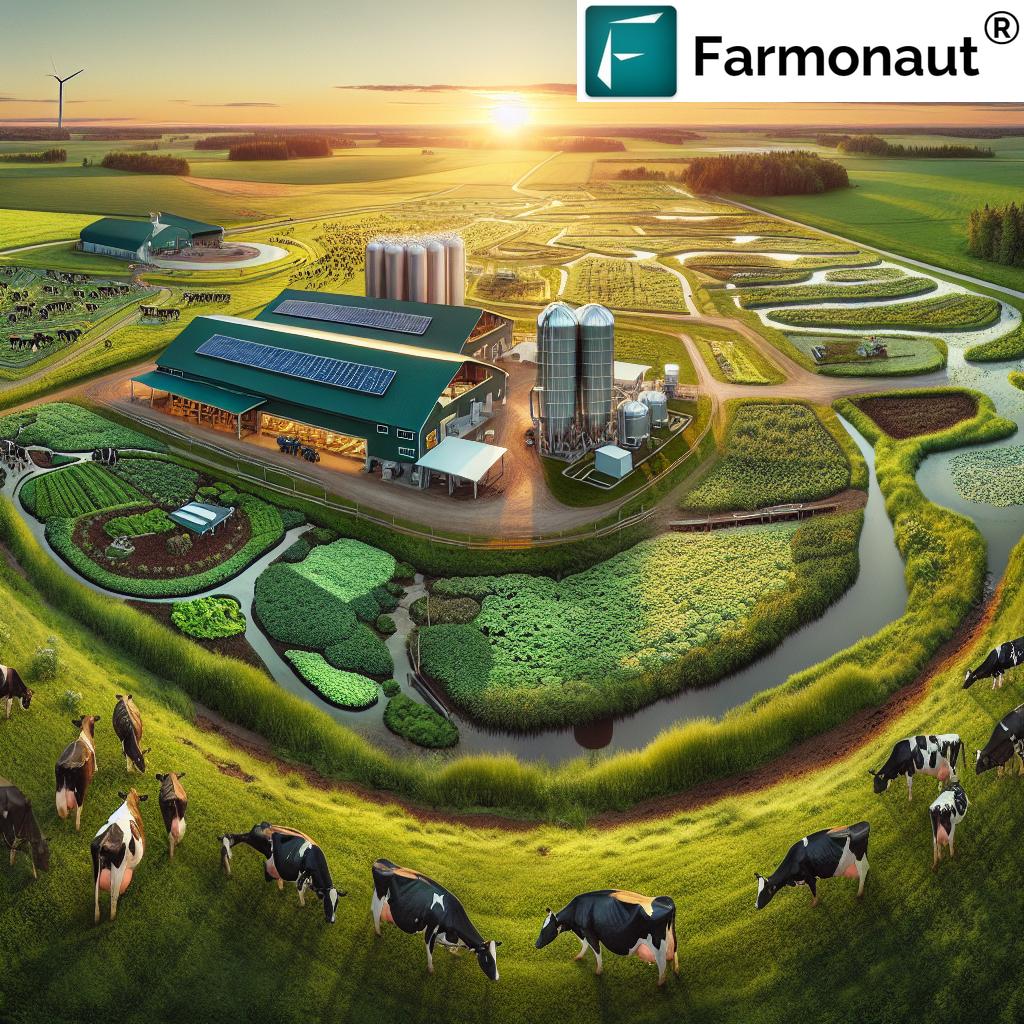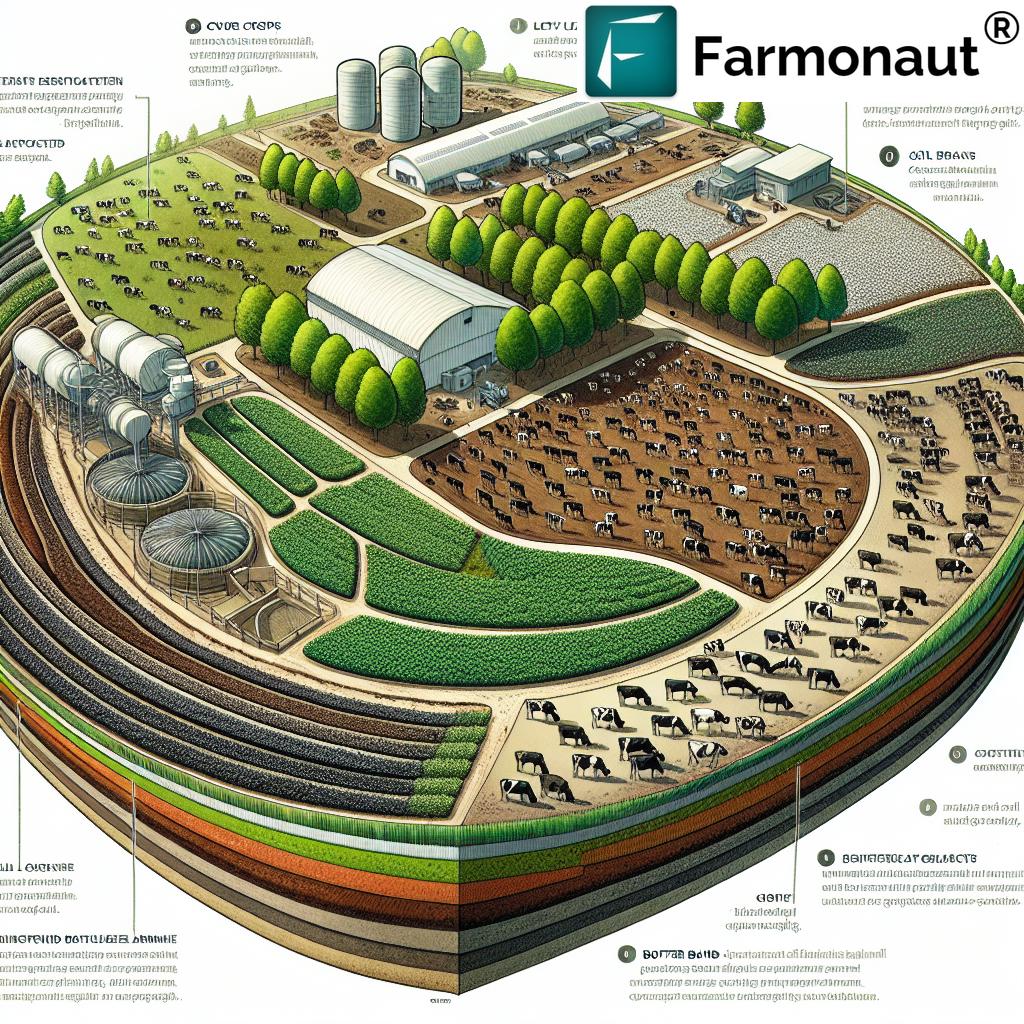Sustainable Canadian Dairy: How Farmers Are Revolutionizing Agriculture for a Net-Zero Future

“Canadian dairy farmers aim to achieve net-zero emissions agriculture by 2050, revolutionizing milk production practices.”
Welcome to our comprehensive exploration of sustainable Canadian dairy farming and the revolutionary practices that are shaping the future of agriculture in the Great White North. As we delve into this exciting topic, we’ll uncover how Canadian farmers are leading the charge towards a net-zero future, embracing innovative techniques and cutting-edge technologies to transform the dairy industry.
In this blog post, we’ll take you on a journey across Canada’s diverse agricultural landscape, from the rolling hills of British Columbia to the vast prairies of Saskatchewan, and from the picturesque farms of Quebec to the rugged coastlines of Newfoundland and Labrador. We’ll explore how dairy farmers in every province and territory – AB, BC, MB, NB, NL, NT, NS, NU, ON, PE, QC, SK, and YT – are contributing to a more sustainable and environmentally friendly dairy sector.
The Canadian Dairy Industry: A Commitment to Sustainability
The Canadian dairy industry has long been a cornerstone of the country’s agricultural sector, providing high-quality milk and dairy products to millions of consumers across the nation. However, in recent years, there has been a growing recognition of the need to address environmental concerns and reduce the industry’s carbon footprint. This realization has sparked a revolution in dairy farming practices, with sustainability at its core.
- Environmental stewardship initiatives
- Innovative approaches to achieve net-zero emissions
- Collaboration between farmers, researchers, and industry stakeholders
As we explore the various aspects of sustainable dairy farming in Canada, we’ll see how these initiatives are not only benefiting the environment but also enhancing the quality of milk production and supporting the long-term viability of the industry.
Regenerative Agriculture: The Foundation of Sustainable Dairy Farming
At the heart of Canada’s sustainable dairy revolution is the adoption of regenerative agriculture practices. These methods go beyond mere sustainability, aiming to actively improve and regenerate the ecosystems in which farming takes place. Let’s delve into some of the key practices being implemented across Canadian dairy farms:
Soil Health Management
Healthy soils are the foundation of any successful agricultural operation, and Canadian dairy farmers are leading the way in innovative soil management techniques. By implementing practices such as no-till farming, cover cropping, and crop rotation, farmers are:
- Increasing soil organic matter
- Enhancing water retention capacity
- Promoting beneficial microbial activity
- Reducing erosion and nutrient runoff
These practices not only improve soil health but also contribute to carbon sequestration, helping to mitigate climate change impacts.
Water Conservation Strategies
Water is a precious resource, and Canadian dairy farmers are implementing various strategies to reduce water usage and improve water quality on their farms. Some of these include:
- Precision irrigation systems
- Rainwater harvesting
- Improved manure management to prevent water contamination
- Riparian buffer zones to protect waterways
By adopting these water-saving techniques, dairy farmers are not only conserving this vital resource but also reducing their overall environmental impact.
Biodiversity Conservation
Preserving and enhancing biodiversity is a crucial aspect of regenerative agriculture. Canadian dairy farmers are taking steps to promote biodiversity on their farms through:
- Creating wildlife corridors
- Planting native species
- Maintaining hedgerows and natural habitats
- Implementing integrated pest management strategies
These efforts not only support local ecosystems but also contribute to the overall resilience of the farm and surrounding landscape.
Technological Innovations in Sustainable Dairy Farming
The journey towards net-zero emissions in Canadian dairy farming is being accelerated by the adoption of cutting-edge technologies. These innovations are helping farmers to optimize their operations, reduce resource use, and minimize environmental impact. Let’s explore some of the key technological advancements revolutionizing the industry:
Precision Agriculture with Farmonaut
One of the most significant technological advancements in sustainable dairy farming is the use of precision agriculture tools. Farmonaut, a leading agricultural technology company, is at the forefront of this revolution, offering advanced satellite-based farm management solutions that are transforming the way Canadian dairy farmers operate.
Farmonaut’s platform provides a range of valuable services, including:
- Real-time crop health monitoring
- AI-based advisory systems
- Resource management tools
- Blockchain-based traceability solutions
By leveraging these tools, dairy farmers can make data-driven decisions that optimize their operations, reduce waste, and improve overall sustainability.
To explore Farmonaut’s innovative solutions, visit their web app or download their mobile apps:
Smart Irrigation Systems
Water management is crucial in dairy farming, and smart irrigation systems are helping farmers to use this precious resource more efficiently. These systems use sensors, weather data, and AI algorithms to determine the optimal irrigation schedule and amount, ensuring that crops receive just the right amount of water at the right time.
Automated Milking Systems
Automated milking systems are revolutionizing dairy operations across Canada. These systems not only improve efficiency but also contribute to better animal welfare and milk quality. By allowing cows to be milked on their own schedule, these systems reduce stress and improve overall herd health.
Emissions Reduction Strategies in Canadian Dairy Farming
Achieving net-zero emissions is a key goal for the Canadian dairy industry, and farmers are implementing various strategies to reduce their carbon footprint. Let’s explore some of the most effective approaches:
Methane Capture and Utilization
Methane emissions from cattle are a significant contributor to the dairy industry’s carbon footprint. To address this, many Canadian dairy farms are investing in anaerobic digesters that capture methane from manure and convert it into biogas. This renewable energy source can be used to power farm operations or sold back to the grid, creating a win-win situation for both the environment and the farmer’s bottom line.
Energy-Efficient Equipment
Replacing old, inefficient equipment with modern, energy-efficient alternatives is another key strategy for reducing emissions. This includes:
- High-efficiency milk cooling systems
- LED lighting
- Variable speed drives on pumps and fans
- Energy-efficient heating and ventilation systems
These upgrades not only reduce energy consumption but also often lead to cost savings for the farm.
Carbon Sequestration through Improved Land Management
Canadian dairy farmers are increasingly recognizing the potential of their land to act as a carbon sink. By implementing practices such as rotational grazing, agroforestry, and cover cropping, farmers can increase the amount of carbon stored in their soils and vegetation, offsetting emissions from other aspects of their operations.

“The proAction food safety standards ensure top-quality, nutritious milk for consumers across all 13 Canadian provinces and territories.”
proAction: Ensuring Quality and Safety in Canadian Dairy
While sustainability is a key focus for Canadian dairy farmers, ensuring the highest standards of food safety and quality remains paramount. The proAction program, developed by Dairy Farmers of Canada, is a comprehensive on-farm quality assurance program that addresses six key areas:
- Milk Quality
- Food Safety
- Animal Care
- Livestock Traceability
- Biosecurity
- Environment
This program ensures that Canadian dairy products meet the highest standards of quality and safety, while also promoting sustainable practices across the industry.
Nutrition and Health Benefits of Canadian Milk
Canadian milk is not only produced sustainably but is also a nutritional powerhouse. Rich in essential nutrients such as calcium, protein, and vitamins, milk plays a crucial role in maintaining overall health and well-being. The sustainable practices employed by Canadian dairy farmers ensure that this nutritious food is produced with minimal environmental impact.
The Role of Research and Innovation in Sustainable Dairy Farming
The transformation of Canadian dairy farming is underpinned by extensive research and innovation. Collaborations between farmers, universities, government agencies, and private sector companies are driving the development of new technologies and practices that enhance sustainability. Some key areas of research include:
- Improving feed efficiency to reduce methane emissions
- Developing drought-resistant forage crops
- Enhancing manure management techniques
- Optimizing cow genetics for improved efficiency and reduced environmental impact
These research initiatives are crucial in ensuring that Canadian dairy farming remains at the forefront of sustainable agriculture globally.
Sustainable Dairy Practices Comparison
| Farming Aspect | Traditional Method | Sustainable Practice | Environmental Impact |
|---|---|---|---|
| Soil Management | Intensive tillage | No-till farming, cover cropping | 30% increase in soil carbon sequestration |
| Water Conservation | Flood irrigation | Precision irrigation systems | 40% reduction in water usage |
| Emissions Reduction | No methane capture | Anaerobic digesters for biogas production | 50% reduction in methane emissions |
| Biodiversity | Monoculture cropping | Diverse crop rotations, wildlife corridors | 25% increase in on-farm biodiversity |
| Technology Integration | Manual monitoring and management | Precision agriculture tools (e.g., Farmonaut) | 20% improvement in resource use efficiency |
Challenges and Opportunities in Sustainable Dairy Farming
While the Canadian dairy industry has made significant strides in sustainability, there are still challenges to overcome and opportunities to explore:
Challenges
- Initial costs of implementing new technologies and practices
- Adapting to changing climate conditions
- Balancing productivity with environmental protection
- Ensuring economic viability for small and medium-sized farms
Opportunities
- Growing consumer demand for sustainably produced dairy products
- Potential for carbon credits and other environmental incentives
- Development of new value-added products from waste streams
- Increased collaboration and knowledge-sharing within the industry
By addressing these challenges and capitalizing on opportunities, the Canadian dairy industry can continue to lead the way in sustainable agriculture.
The Future of Sustainable Canadian Dairy
As we look to the future, the Canadian dairy industry is well-positioned to achieve its goal of net-zero emissions by 2050. The continued adoption of innovative technologies, such as those offered by Farmonaut, will play a crucial role in this journey. Farmers across the country, from the coastal regions of British Columbia to the rolling hills of Prince Edward Island, are embracing these changes and leading the way in sustainable agriculture.
The commitment to sustainability extends beyond individual farms to encompass the entire dairy supply chain. From farm to table, stakeholders are working together to reduce environmental impact, improve animal welfare, and deliver high-quality, nutritious dairy products to Canadian consumers.
For those interested in leveraging Farmonaut’s technology for sustainable farming, explore their API and API Developer Docs.
Conclusion
The Canadian dairy industry is at the forefront of a revolution in sustainable agriculture. Through the adoption of regenerative practices, cutting-edge technologies, and a commitment to continuous improvement, dairy farmers across the country are paving the way for a more sustainable and resilient food system.
As consumers, we can support these efforts by choosing Canadian dairy products and recognizing the hard work and dedication of our nation’s farmers. Together, we can build a future where delicious, nutritious dairy products are produced in harmony with the environment, ensuring a sustainable legacy for generations to come.
FAQ: Sustainable Canadian Dairy Farming
Q1: What is net-zero emissions agriculture?
A: Net-zero emissions agriculture refers to a farming system where the amount of greenhouse gases emitted is balanced by the amount removed from the atmosphere through various practices and technologies.
Q2: How are Canadian dairy farmers reducing their carbon footprint?
A: Canadian dairy farmers are reducing their carbon footprint through various methods, including methane capture, energy-efficient equipment, improved feed management, and carbon sequestration through better land management practices.
Q3: What is regenerative agriculture, and how does it apply to dairy farming?
A: Regenerative agriculture is an approach that focuses on improving soil health, enhancing biodiversity, and restoring ecosystems. In dairy farming, this includes practices like rotational grazing, cover cropping, and no-till farming.
Q4: How does technology like Farmonaut contribute to sustainable dairy farming?
A: Farmonaut’s satellite-based farm management solutions help dairy farmers optimize their operations by providing real-time data on crop health, soil moisture, and weather patterns. This enables more efficient resource use and better decision-making.
Q5: What is the proAction program?
A: proAction is a comprehensive quality assurance program developed by Dairy Farmers of Canada that covers six key areas: milk quality, food safety, animal care, livestock traceability, biosecurity, and environmental sustainability.





